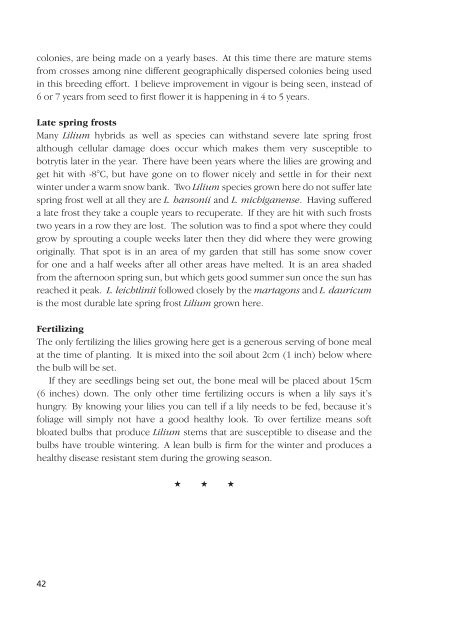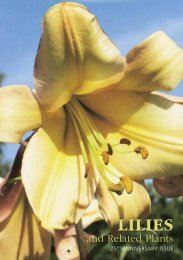Lilies and Related Plants - RHS Lily Group
Lilies and Related Plants - RHS Lily Group
Lilies and Related Plants - RHS Lily Group
Create successful ePaper yourself
Turn your PDF publications into a flip-book with our unique Google optimized e-Paper software.
colonies, are being made on a yearly bases. At this time there are mature stems<br />
from crosses among nine different geographically dispersed colonies being used<br />
in this breeding effort. I believe improvement in vigour is being seen, instead of<br />
6 or 7 years from seed to first flower it is happening in 4 to 5 years.<br />
Late spring frosts<br />
Many Lilium hybrids as well as species can withst<strong>and</strong> severe late spring frost<br />
although cellular damage does occur which makes them very susceptible to<br />
botrytis later in the year. There have been years where the lilies are growing <strong>and</strong><br />
get hit with -8°C, but have gone on to flower nicely <strong>and</strong> settle in for their next<br />
winter under a warm snow bank. Two Lilium species grown here do not suffer late<br />
spring frost well at all they are L . hansonii <strong>and</strong> L . michiganense. Having suffered<br />
a late frost they take a couple years to recuperate. If they are hit with such frosts<br />
two years in a row they are lost. The solution was to find a spot where they could<br />
grow by sprouting a couple weeks later then they did where they were growing<br />
originally. That spot is in an area of my garden that still has some snow cover<br />
for one <strong>and</strong> a half weeks after all other areas have melted. It is an area shaded<br />
from the afternoon spring sun, but which gets good summer sun once the sun has<br />
reached it peak. L . leichtlinii followed closely by the martagons <strong>and</strong> L . dauricum<br />
is the most durable late spring frost Lilium grown here.<br />
Fertilizing<br />
The only fertilizing the lilies growing here get is a generous serving of bone meal<br />
at the time of planting. It is mixed into the soil about 2cm (1 inch) below where<br />
the bulb will be set.<br />
If they are seedlings being set out, the bone meal will be placed about 15cm<br />
(6 inches) down. The only other time fertilizing occurs is when a lily says it’s<br />
hungry. By knowing your lilies you can tell if a lily needs to be fed, because it’s<br />
foliage will simply not have a good healthy look. To over fertilize means soft<br />
bloated bulbs that produce Lilium stems that are susceptible to disease <strong>and</strong> the<br />
bulbs have trouble wintering. A lean bulb is firm for the winter <strong>and</strong> produces a<br />
healthy disease resistant stem during the growing season.<br />
42<br />
★ ★ ★




